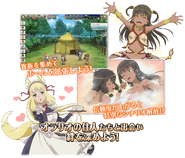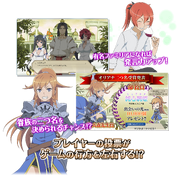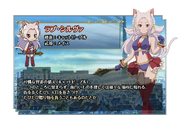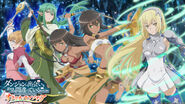DanMachi Orario Rhapsodia (ダンまち オラリオ・ラプソディア) was a PC browser game created and operated by Gree that was released on Yahoo! Japan. After a month delay, it was released on November 21, 2017. The service ended on May 15, 2019.
Information[]
Story[]
The player played as a God and start a Familia, gathering children to explore the dungeon, with Emma Flores as their first Familia member. The game was completely supervised by the author, Oomori Fujino, and was stated that the game would have more than 700 episodes of content. Emma is the only voiced character in the game.
Gameplay[]
Main Menu[]
From the main screen, players could access a variety of options through the buttons at the top and right hand side of the screen.
Quests[]
There were four different types of quest: daily, weekly, achievements, and beginner, with a number of quests for each category. Each quest could be cleared by fulfilling a certain requirement and rewarded the player with items or valis.
Dungeon[]
Players had an AP gauge that decreased when starting a story stage or quest and were able to restore lost AP points by using items or levelling up. Story stages consisted of a small map which players had the leaders of their parties (maximum of 3, though certain stages had restrictions) walk through, comprised of normal spaces, trap spaces, recovery spaces, item gathering points, enemy encounters, and an end of level flag. Walking allowed players to move one space at a time while running covered two spaces.
Combat[]
There were two types of enemy icons: white normal and red boss ones, though the latter only appeared on the last stage of a set. Upon entering combat, the player's party status was shown on the left while the enemy status was shown on the right, with options shown at the bottom. In addition to an HP bar, enemies also had a break bar that caused them to stop attacking for a certain period of time if depleted.
The bottom selection consisted of the attack, action, enhance, assist, item, two supporter, and the Link Assault button. Players could check the combat order with the bar above the buttons at the bottom. All characters that attacked after the first character dealt more damage and upped the combo counter until it was reset when the enemies attacked. The action and enhance button effects were different for each character as they were dependant on the card set, the assist button used the skill of one of the assist characters set with the party, and the item button allowed the player to use a variety of items to heal their party or damage their enemies. The player was also able to set two supporters which could help with their skills, such as damaging all enemies. The Link Assault button allowed the player to do an all out attack with all party members and was charged by attacking.
Gallery[]
Trivia[]
- Prior to release, the designs of the featured game original characters were modified to resemble the anime's design style.



































